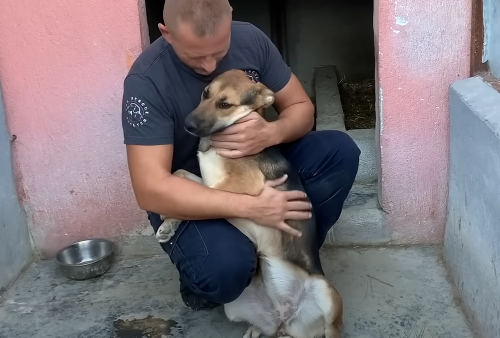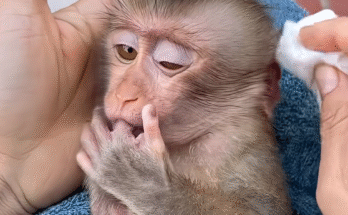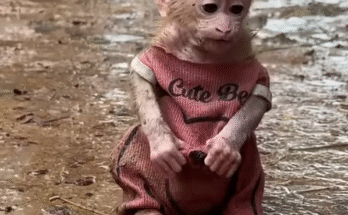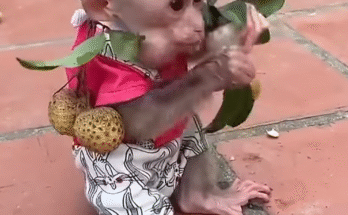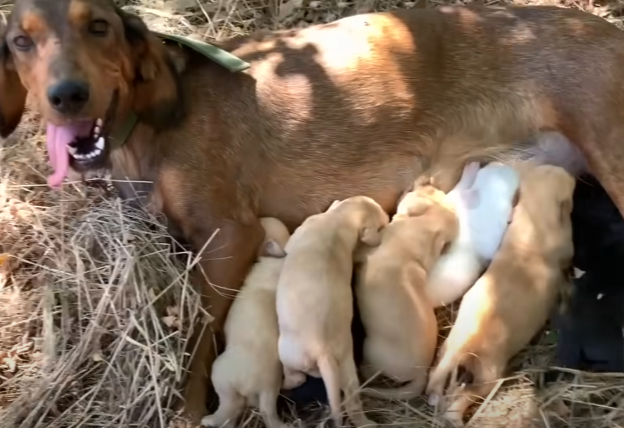
In the world of animal rescue, some cases stand out for their heartbreak, urgency, and ultimate triumph. One such story is the rescue of an abandoned mother dog, chained and left to care for her seven newborn puppies alone. The situation was dire — frail, malnourished, and overwhelmed, the mother faced the impossible task of nurturing her litter in harsh, neglected conditions. This full rescue not only saved lives but also highlighted the power of compassion, patience, and the human-animal bond.
The Discovery
The first sight of the mother dog and her litter was gut-wrenching. Hidden behind an abandoned shed, the mom was tethered to a rusty chain, with barely enough room to lie down. The newborn puppies were huddled close to her, mewling softly — a fragile symphony of life struggling against neglect. Their tiny bodies were covered in dirt, eyes barely open, and they were dependent entirely on their mother for warmth, nourishment, and protection.
Neighbors had noticed the abandoned dog but were either too afraid or indifferent to intervene. It was clear that time was critical. Every hour left untreated could mean the difference between life and death for the puppies. Their survival depended on immediate and careful action.
Assessing the Situation
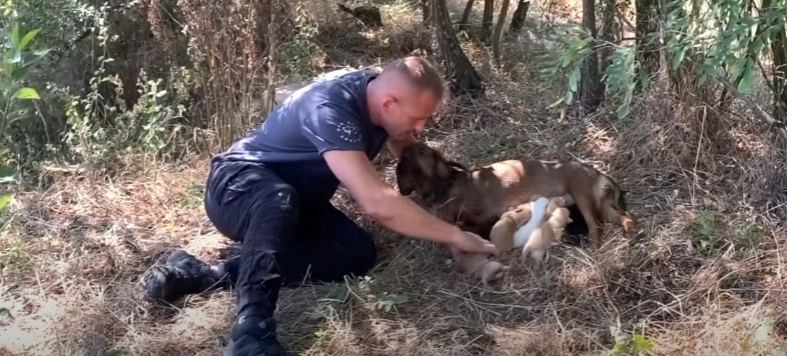
Before attempting a rescue, it was essential to understand the mother’s condition. She was wary, protective, and understandably distrustful of humans after abandonment. Her body was thin, her fur matted, and she bore the marks of prolonged neglect. Despite her condition, there was a spark of maternal instinct — she was trying her best to nurse and clean her puppies, using what little strength she had.
The puppies themselves were fragile and highly vulnerable. Newborn puppies cannot regulate their body temperature and rely completely on their mother for nutrition. Any rescue attempt had to be careful, calm, and structured to avoid further distress or injury.
Planning the Rescue
The rescue required a detailed plan. Approaching a protective mother dog with seven tiny puppies is delicate work. Sudden movements or loud noises could provoke defensive behavior. The rescue team took several precautions:
- Calm Approach: They spoke softly, approached slowly, and allowed the mother to observe them before any physical contact.
- Prepared Supplies: Clean blankets, food, water, and medical supplies were ready to ensure immediate care for both mother and puppies.
- Safety Measures: Gloves, leashes, and gentle restraint techniques were prepared to protect both humans and animals.
- Separation Strategy: While the puppies needed to remain close to their mother, small adjustments were necessary to safely transport them without causing panic or injury.
The priority was building trust and minimizing stress while ensuring the safety of all involved.
The Rescue Moment
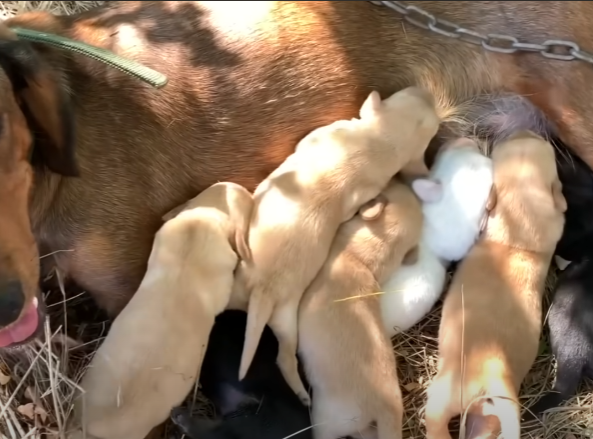
Once everything was ready, the rescue began. The mother dog initially growled and backed away, her instincts telling her to protect her vulnerable puppies. With patience and soothing words, the rescuers slowly gained her trust. Food was offered, hands were extended gently, and the chain was carefully unlocked without sudden movements.
When the chain was removed, a visible sense of relief washed over her. She cautiously followed the rescuers, her body tense but increasingly relaxed. The puppies, sensing the change, began to explore slightly beyond their cramped space, their tiny movements filled with curiosity and uncertainty.
One by one, the puppies were gently wrapped in soft blankets and carried to safety alongside their mother. Every step was handled with care to avoid dropping, startling, or injuring the fragile litter. Finally, the family was free from the chains, both physical and metaphorical, that had constrained them for so long.
Immediate Care and Recovery
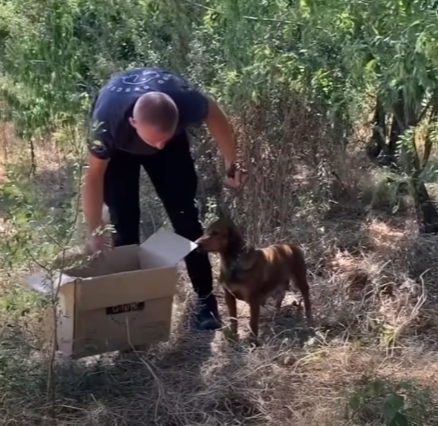
Once transported to a safe and clean environment, the mother and her puppies received immediate attention. The mother was given food and water, her malnutrition addressed gradually to prevent digestive distress. Her fur was cleaned and matted areas gently removed, revealing her lean but strong frame.
The puppies were checked individually. Their eyes were examined for infection, their small bodies assessed for dehydration, and their tiny limbs inspected for signs of injury. Warmth was provided through blankets and heat pads, ensuring that they could regulate their body temperature effectively.
The mother, initially nervous and protective, gradually began to relax in her new surroundings. The soothing environment, regular feeding, and gentle handling allowed her to regain confidence, and she started attending to her puppies naturally once again.
Bonding and Socialization
One of the most critical aspects of post-rescue care is fostering bonding and socialization. The mother dog needed reassurance that she was safe and that the humans around her were allies, not threats. Over several days, the rescuers worked to build trust:
- Gentle Interaction: Soft words, calm gestures, and patient handling helped her understand she was no longer in danger.
- Routine Feeding: Regular, nutritious meals restored her strength and reinforced a sense of security.
- Puppy Monitoring: Each puppy received attention, ensuring they remained healthy and continued to grow while strengthening the mother’s confidence in her ability to nurture.
- Play and Exploration: As the puppies grew stronger, supervised play sessions encouraged social development, exercise, and natural behaviors.
The Transformation
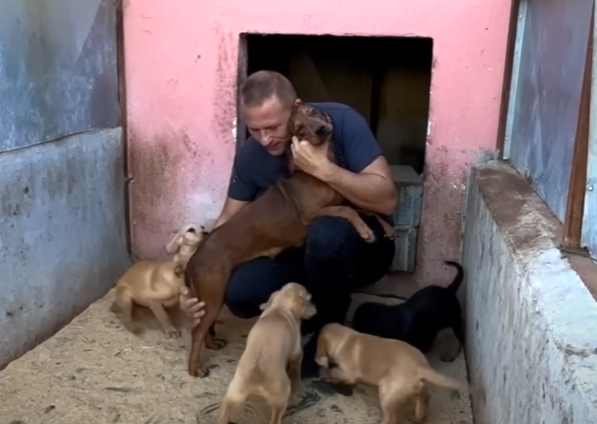
Within weeks, the transformation was remarkable. The mother, once chained and fearful, became more relaxed, affectionate, and confident. Her puppies, tiny and fragile at first, grew stronger, healthier, and more active with each passing day. Their playful antics — tentative steps, tiny barks, and exploratory sniffs — became a testament to the resilience of life even after hardship.
The rescue had not only saved them physically but had also given them a chance for emotional healing. The mother’s trust in humans had been restored, and the puppies’ early trauma from abandonment was replaced by warmth, nourishment, and safety.
Lessons Learned
The rescue of the abandoned chained mother and her seven newborn puppies offers several key lessons:
- Compassion Can Save Lives: A single act of intervention can completely alter the fate of abandoned animals. Without timely help, the outcome for the mother and puppies could have been fatal.
- Patience is Crucial: Trust must be rebuilt carefully, especially in traumatized animals. Rushing the process can lead to setbacks or defensive behaviors.
- Immediate Care Matters: Proper nutrition, warmth, and medical attention are critical for survival in cases of severe neglect.
- Resilience is Remarkable: Despite abandonment and suffering, animals possess incredible strength and adaptability, often responding quickly to kindness and care.
- Community Awareness: Many rescues rely on vigilance and reporting from neighbors or passersby. Awareness and action can prevent prolonged suffering.
Finding Forever Homes
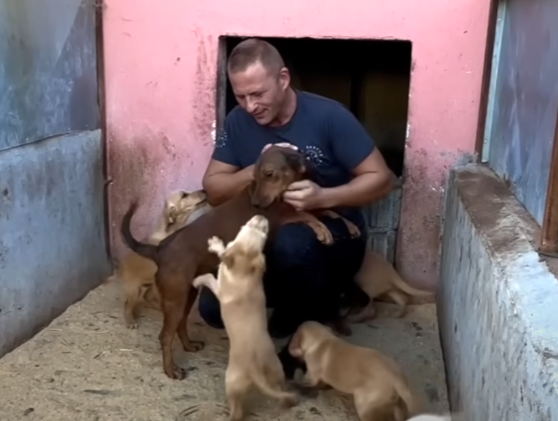
As the mother and puppies continued to grow stronger, the next step was ensuring their long-term well-being. Veterinary care confirmed their health, vaccinations were administered, and socialization continued to prepare them for adoption.
Eventually, loving families were found for each puppy, ensuring that they would grow up in safe, nurturing environments. The mother, too, found a home where she could live comfortably, no longer chained or neglected, and surrounded by care and affection.
Conclusion
The story of the abandoned chained mother dog with seven newborn puppies is a powerful reminder of the fragility and resilience of life. From a scene of neglect and danger emerged hope, recovery, and transformation. The rescue demonstrated the impact of compassion, patience, and diligent care, highlighting how humans can make a profound difference in the lives of abandoned animals.
From trembling cries of fear to wagging tails of joy, the journey of this family illustrates the potential for healing when love, attention, and care are applied consistently. It is a testament to the power of intervention, the courage of the rescued, and the enduring bond that forms between humans and animals when trust is restored.
Every step of this rescue — from discovering the chained mother and her tiny litter to seeing them thrive in safe homes — is a story of hope and perseverance. It serves as a call to action for awareness, empathy, and action in the face of animal abandonment. In the end, what began as a heartbreaking scene transformed into a tale of survival, love, and the unbreakable spirit of life.
